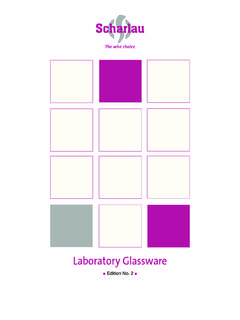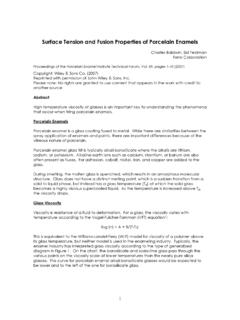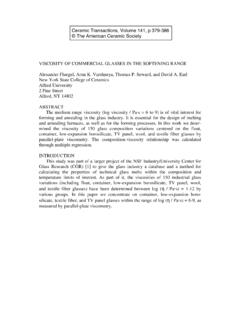Transcription of PYREX Technical Information - Pegasus Glass
1 PYREX Technical Information Properties Of borosilicate ( PYREX 7740) Glass Chemical ResistanceBorosilicate Glass is inert to almost all materials with the exception of hydrofluoric acid, hot phosphoric acid and hot alkalies. Of these, hydrofluoric acid has the most serious effect and, even when a solu-tion contains a few parts per million, attack will occur. Phosphoric acid and caustic solutions cause no problems when cold but at elevated temperatures corrosion occurs. Caustic solutions up to 30% concentration can be handled safely at ambient tem-peratures. Physical Properties:Composition Low-expansion borosilicate Glass has the following approximate chemical composition: SiO2 81% Na2O K2O B2O3 Al2O3 For further details please refer to ASTM E 438, Standard Specification for Glasses in Laboratory Ap-paratus. Linear Coefficient of Expansion:Between 32 F and 572 F [0 C and 300 C], per ASTM Method E 228) x 10-7 in/in/7 cm/cm/ C Annealing:All fittings and all straight lengths are annealed to reduce internal stress.
2 This also makes the pipe easier to field fabricate. Thermal Btu/hr-ft2- cal/sec-cm2- C/cm Specific Btu/lb- cal/gm- C Dialectric Constant:at 23 C and 1M Hz per ASTM Method D 150: Density:Approximately 139 lb/ft3 ( gm/cm3) Young s Modulus:per ASTM Method C215: in the range of 9 x 106 to 10 x 106 psi. Mechanical Strength:The mechanical properties of Glass differ from those of metals. The lack of ductility of Glass prevents the equalization of stresses at local irregularities or flaws and the breaking strength varies consider-ably about a mean value. This latter is commonly found to occur at a tensile strength of about 70 kg/cm2 (1000 psi). The Glass should be adequately supported and appropriate allowance should be made for special conditions such as high temperatures, dense liquids, etc. Subject to the above, maximum working pressures are as specified in the following table.
3 Working Temperatures borosilicate Glass retains its mechanical strength and will deform only at temperatures which ap-proach its strain point. The practical upper limit for operating temperatures Is much lower and is con-trolled by the temperature ditterentials in the Glass , which depend on the relative temperatures of the contents of the equipment and the external surroundings. Provided borosilicate Glass is not subjected to rapid change in temperature, creating undue thermal shock, it can be operated safely at temperatures up to 450 F (232 C). The normal limiting factor is actually the gasket material. The degree of thermal shock (usually defined as sudden chilling) which it can withstand depends on many factors, for example: stresses due to operating conditions; stresses imposed in supporting the equipment; the wall thickness of the Glass , etc. It is therefore undesirable to give an overall figure but, as a general guide, sudden temperature changes of up to about 216 F (120 C) can be accommodated At sub-zero temperatures, the tensile strength of borosilicate Glass tends to increase and equipment can be used with safety at cryogenic temperatures.
4


